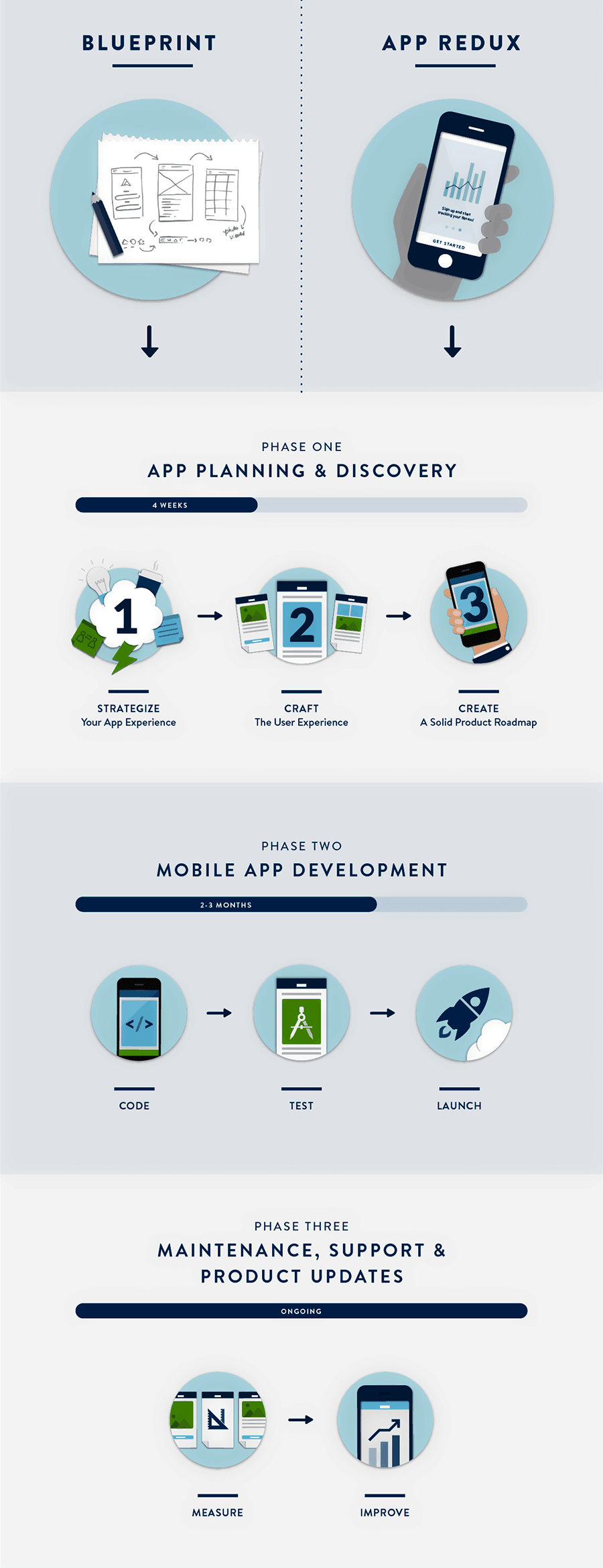How long does it take to build an app?
It’s one of the most common questions we get…
How long does it take to go from an idea to a fully functioning app?
How long does it take to design the interface?
How long does it take to write the code?
We’ve heard it time and time again. The only question we get more frequently is:
How much will it cost to build an app?
Turns out those two questions are related. When it comes to building an iPhone app (or an Android app) the amount of time it takes will depend in part on your budget, as well as the functionality you’re looking for, the expertise of the design and development team, and their process. Which means… there’s no easy answer to this question.
But to help you get an idea of the timing, the best approach we can take is to draw from our own experience. So in this article, we’re going to break down our process and our typical timeline for helping organizations bring apps to life. Let’s get to it.
What Key Factors Go Into Creating A Mobile App?
While the timing and the cost of building an app are often directly related, as mentioned, there are a number of other factors that impact the time between initial contact and app launch, including your organization’s design needs, the app’s defined functionality, the intricacy of the user experience, feedback from users during the testing process and more. Of all the things that go into a mobile app, these two factors influence the timeline the most:
Information Provided Prior To Development
What information have you already gathered? What work has already been done? Have you already established a set of priorities for the app, or created mockups? Will you require in-app payments? Do you need to have a logo designed? Do you need brand guidelines?
The answers to all these questions will influence your app-building timeline.
Organizations that have already planned their app experience, talked to their customers, built a handful of mockups, or previously put an app on the market have an advantage. Providing this information to the app agency you’re working with will help them understand your situation and more accurately build a timeline.
Collaboration & Communication
When it comes to communicating with your app agency and approving progress on the app, how many people need to be involved in the decision-making? Should multiple departments have a say? How many levels of approvals are necessary? Are you willing to invest the time to give your app agency quick approvals?
Again: The answers to these questions will have an impact on the timeline.
For many companies, the creation of a mobile app is a pivotal business decision; as a result, the app is a top priority (good) but lots of people may want to be involved—meaning approvals can take time.
Other companies don’t give their app development projects that kind of internal attention. When your app is low on the priority list, communication and approvals are a slow go, and a process that could have taken eight weeks takes eight months.
What Is The Mobile App Development Process?
At MindSea, the mobile app development process depends on the client’s situation. Sometimes organizations have a pre-existing app that needs a makeover; other times, organizations come to us with nothing more than a brilliant idea.
We serve both types of clients, and our timeline is typically three months from starting a project to getting the app approved and launched in the app store. While the initial efforts are different, the end result is often the same:
Phase One: App Planning & Discovery [4 Weeks]
Our strategy development process around how to build an app is built on three key elements: (1) strategizing your app experience (2) crafting the user experience and (3) creating a solid product roadmap. If you’re building an app from scratch, we call this phase the blueprint process, but if you have an existing app we call it an app redux. While some elements differ between the two, typically the experience is consistent across both situations.
Strategizing Your App Experience
During the strategy portion of creating a blueprint, we work with clients to establish a clear timeline by understanding their circumstances. We introduce ourselves to the client’s internal mobile development team and confirm project expectations. Then we hold a workshop to discuss business goals, target audiences, priority features and insights that will help you create an app that is more likely to find product-market fit.
Crafting The User Experience
Just as no one would attempt to build a house without a blueprint, we don’t think you should try to build an app without a blueprint either. That’s why we craft a user experience that is so close to completion, it can be passed to any developer for implementation. Our deliverable at this stage is an architecture that consists of defining the user journey, sketches of the experience screen by screen, high-fidelity mockups, and followed by the creation of a working prototype that you can test and demo.
Creating A Solid Product Roadmap
Once designs are completed, we provide clients with detailed technical requirements and UX documentation that any experienced mobile team can work with. This product roadmap arms clients with everything they need to build their app—and the info they need to set budgets for the short and long term.
To this point, two key reasons the process has gone smoothly, without delays and scope extensions, are timely approvals and consistent collaboration.
Phase Two: Mobile App Development [2+ Months]
Once the research, designs, and road map are out of the way, it’s time for the build. The development phase takes place primarily on our end with very little work for clients — the developers and programmers use this time to write code and create a great app experience.
The length of the development phase depends on the app’s complexity per the roadmap from phase one. If your app is mostly for information purposes and only offers a few interactions, it might be built in less than a month. Yet a more complicated app with an inventory, geo-location, social logins, dynamic content and a user database could take double or even triple the effort—and therefore time.
Prior to going live in the app store, we give your team a chance to demo and test the app. We’ll conduct quality assurance, squash bugs and make any final design adjustments that make sense for your audience.
Phase Three: Maintenance, Support & Product Updates [Ongoing]
Once the app has been developed, approved by the app store and downloaded by real people, it’s time to pop a bottle of champagne, sure—but it’s also time to keep things moving in the right direction. This is when you determine which features to build next and implement ongoing testing to keep the app working correctly.
To help plan for this part, the roadmap we deliver in phase one outlines specific features and updates that can be developed in the months following the launch.
Wrapping Things Up:
So can you launch in less than two months?
Of course you can.
The timeline we’ve shared here is solely based on our own experience with typical clients. Some apps don’t require much design and development work because the client already has the assets. If you’re in that situation, your app could probably be built more quickly.
Of course every organization’s situation is unique, and there are many other variables that influence the timeline. If you’re interested in getting a rough estimate of how much time it would take for our team to help you bring an app to life, get in touch. We’d love to chat.




